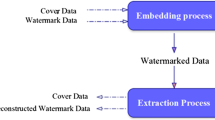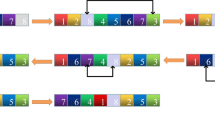Abstract
Self-recoverable fragile watermarking is meant for accurate tamper localization as well as image recovery with superior visual quality. However, most of the existing state of art approaches perform authentication and recovery on block basis owing to which the entire block is categorized as tampered in case of alteration of one or more pixels of it. This, results in staircase formation of tamper detected regions, hence lacking in accuracy. Furthermore, the visual quality of the recovered image also deteriorates as an approximate value is assigned to all the block pixels corresponding to the altered region. The proposed watermarking scheme performs both authentication and recovery pixelwise. The authentication of each pixel is done via multi level tamper detection(MLTD) through three authentication bits based on value, location and neighbourhood information. The domain for image recovery is chosen dynamically based on the content of the block, may it be in spatial domain for smooth blocks or frequency domain for the rough ones. This provides high accuracy in recovery. As the embedding of recovery information is done in the frequency domain, the imperceptibility of the watermarked image scheme remains high. Also, embedding of authentication information in the spatial domain maintains its fragile nature. Even for higher tampering ratios, the lost content is rebuilt with high peak signal to noise ratio(PSNR) of the recovered image. The probabilities of false rejection and false acceptance head towards the ideal value for most of the empirical analysis. Comparative study via metric evaluation of probability of false rejection (PFR), probability of false acceptance (PFA) and PSNR of recovered image for different standard test cover images demonstrate the efficacy of the proposed scheme over other existing state of art approaches. Further, the security of the proposed scheme remains high due to usage of multi-layered secret keys and chaos based random mapping handling worst tamper scenarios.












Similar content being viewed by others
References
Abuturab MR (2012) Color image security system using double random-structured phase encoding in gyrator transform domain. Appl Opt 51:3006–3016
Abuturab MR (2012) Color information cryptosystem based on optical superposition principle and phase-truncated gyrator transform. Appl Opt 51:7994–8002
Abuturab MR (2013) Authentication system of color information using interference of two beams in gyrator transform domain. Appl Opt 52:5133–42
Chamlawi RA, Khan A (2010) Digital image authentication and recovery: sinteger transform based information embedding and extraction. Inf Sci 180:4909–4928
Chen LF, Zhao DM, Ge F (2010) Opt Commun 283:2043
Chen F, He H, Huo Y, Wang H (2011) Self-recovery fragile watermarking scheme with variable watermark payload. Proc Int Conf IWDW LNCS 7128:142–155
Chen F, He H, Tai H, Wang H (2012) Chaos-based self-embedding fragile watermarking with flexible watermark payload. Multimedia Tools Appl 72:41–56
Fridrich J, Goljan M (1999) Protection of digital images using self embedding. In: Content Security and Data Hiding in Digital Media. NJIT, NJ
Fridrich J, Goljan M, Memon N (2002) Cryptanalysis of the Yeung-Mintzer fragile watermarking technique. J. Electron Imaging 11:262–274
He HJ, Zhang JS, Tian L (2005) A fragile watermarking scheme with discrimination of tampers on image or watermark. Acta Elect Sin 33(9):1557–1561
He H, Zhang J, Tai HM (2009) Self-recovery fragile watermarking using block-neighborhood tampering characterization. Proc Int Conf Inf Hiding Work LNCS 5806:132–145
He HJ, Zhang JS, Tai HM (2008) Block-chain based watermarking scheme with superior localization. In: IHW, pp 137–160
Hennelly B, Sheridan JT (2003) Opt Lett 28:269
Holliman M, Memon N (2000) Counterfeiting attacks on oblivious block-wise indepen-dent invisible watermarking schemes. IEEE Trans Image Process 9(3):432–441
Huo Y, He H, Chen F (2012) Alterable-capacity fragile watermarking scheme with restoration capability. Opt Commun 285:1759–1766
Hwang HE, Han P (2006) Fast algorithm of phase masks for image encryption in the Fresnel domain. J Opt Soc Am A 23:1870–4
Lee TY, Lin SD (2008) Dual watermark for image tamper detection and recovery. Pattern Recog 41:3497–3506
Li C, Zhang A, Liu Z, Liao L, Huang D (2014) Semi-fragile self-recoverable watermarking algorithm based on wavelet group quantization and double authentication. Multimedia Tools Application, pp 1380–7501
Li G B, Pei S W, Chen G, Cao W, Wu B (2009) A Self-embedded watermarking scheme based on relationship function of corresponding inter-blocks DCT coefficient. In: Proceedings of the 2009 13th international conference on computer supported cooperative work in design, pp 107– 112
Lin PL, Hsieh CK, Huang PW (2005) A hierarchical digital watermarking method for image tamper detection and recovery. Pattern Recog 38(12):2519–2529
Liu Z, Xu L, Liu T, Chen H, Li P, Lin C, Liu S (2011) Color image encryption by using Arnold transform and color-blend operation in discrete cosine transform domains. Opt Commun 284: 123–8
Liu ZJ, Li QM, Dai JM (2009) Opt Commun 282:1536
Phadikar A, Maity S, Mandal M (2012) Novel wavelet-based QIM data hiding technique for tamper detection and correction of digital images. J Vis Commun Image Represent 23:454–466
Qian Z, Feng G, Zhang X, Wang S (2011) Image self-embedding with high-quality restoration capability. Digit Signal Process 21:278–286
Refregier P, Javidi B (1995) Optical image encryption based on input plane and Fourier plane random encoding. Opt Lett 20:767–9
Seng WC, Du J, Pham B (2009) Semi Fragile Watermark with Self Authentication and Self Recovery. Malays J Comput Sci 22(1):64–84
Situ G, Zhang J (2004) Double random-phase encoding in the Fresnel domain. Opt Lett 29: 1584–6
Shivani S, Singh D, Agarwal S (2013) DCT Based Approach for Tampered Image Detection and Recovery Using Block Wise Fragile Watermarking Scheme. LNCS, 7887, pp 640–647
Suthaharan S (2004) Fragile image watermarking using a gradient image for improved localization and security. Pattern Recogn Lett 25:1893–1903
Tao R, Xin Y, Wang Y (2007) Opt Express 15:16067
Tsai MJ, Chien C (2008) Authentication and recovery for wavelet-based semifragile watermarking. Opt Eng 47(6):1–9
Unnikrishnan G, Joseph J, Singh K (2000) Opt Lett 25:887
Wang MS, Chen WC (2007) A majority-voting based watermarking scheme for color image tamper detection and recovery. Comput Stand Interfaces 29(5):561–570
Wo Y, Han GQ, Zhang B (2005) A new Feature-based image content authentication algorithm. Chin J Comput 28(1):105–112
Wong PW, Memon N (2001) Secret and public key image watermarking schemes for image authentication and ownership verification. IEEE Trans Image Process 10 (10):1593–1601
Yang C, Shen J (2010) Recover the tampered image based on VQ indexing. Signal Process 90:331–343
Zhang X, Wang S, Qian Z, Feng G (2011) Reference sharing mechanism for watermark self-embedding. IEEE Trans Image Process 20(2):485–495
Author information
Authors and Affiliations
Corresponding author
Rights and permissions
About this article
Cite this article
Singh, P., Agarwal, S. An efficient fragile watermarking scheme with multilevel tamper detection and recovery based on dynamic domain selection. Multimed Tools Appl 75, 8165–8194 (2016). https://doi.org/10.1007/s11042-015-2736-9
Received:
Revised:
Accepted:
Published:
Issue Date:
DOI: https://doi.org/10.1007/s11042-015-2736-9




